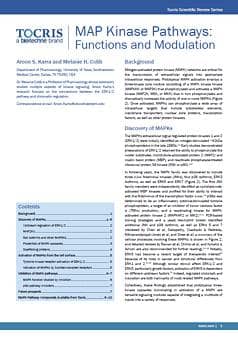Nerve Growth Factor IB-like Receptors
Nerve growth factor IB-like receptors (nuclear hormone receptor 4A, NR4A) are a group of orphan nuclear receptors, comprising three members Nur77 (NR4A1), Nurr1 (NR4A2) and NOR1 (NR4A3). They are widely expressed and have a role in immune and energy regulation, as well as being implicated in a range of cancers.
Nerve Growth Factor IB-like Receptor Agonists |
|
|---|---|
| Cat. No. | 产品名称/活性 |
| 5459 | Cytosporone B |
| High affinity Nur77 agonist | |
Nerve Growth Factor IB-like Receptor Antagonists |
|
| Cat. No. | 产品名称/活性 |
| 6377 | DIM-C-pPhOH |
| Nur77 antagonist | |
Nerve Growth Factor IB-like Receptor Activators |
|
| Cat. No. | 产品名称/活性 |
| 5821 | C-DIM 12 |
| Nurr1 activator; inhibits NF-κB-dependent gene expression | |
| 5699 | IP7e |
| Potent Nurr1 activator | |
NR4As are constitutively active and no endogenous ligands have been identified to date. The effects of these receptors are context and tissue dependent, and are governed by their expression levels, post-translational modification and interaction with other transcription factors.
NR4As are key regulators of inflammatory processes and immune homeostasis and are expressed at high levels in chronically inflamed tissues, such as in atherosclerosis, psoriasis, colitis or rheumatoid arthritis. They integrate and limit inflammatory signaling and promote tissue repair, so are potentially a target of interest for anti-inflammatory therapies. NR4A gene expression is regulated by NF-κB, but NR4As also have a regulatory feedback role controlling NF-κB activity and pro-inflammatory target gene expression by suppressing NF-κB transcriptional activity.
Cancer is another area in which NR4As are implicated. They have pro-angiogenic effects via the VEGF pathway, as well as affecting p53, MAPK and Wnt/β catenin pathways leading to anti-apoptotic and proliferative effects. NR4As are also involved in the DNA damage response, translocating to sites of dsDNA damage repair in a mechanism that is dependent on PARP-1. In addition NR4A2 receptors have been reported to be involved in inducing expression of enzymes associated with fatty acid oxidation in colon cancer cells, allowing cells to switch to alternative oxidative pathways so promoting cell survival.
NR4As are also important in lipid, carbohydrate and energy metabolism and may be of interest in dyslipidemia, obesity, diabetes and cardiovascular disease. In muscle, adipose tissue and liver, NR4As are induced by β-adrenergic signaling, and are thought to transcriptionally regulate metabolic function. This effect is mediated by cAMP, protein kinase A, MAPK and cAMP response element-binding protein. In the liver, NR4As are also induced by glucagon and fasting, resulting in gluconeogenesis. Increased expression in liver also leads to reduced hepatic triglyceride content and reduced expression of SREBP-1c, a regulator of lipid and cholesterol metabolism. In brown adipose tissue NR4As may also be induced by cold and during adipogenesis, while in white adipose tissue, insulin and insulin sensitizers increase expression of these receptors. In addition, NR4As are induced by atherogenic stimuli, are expressed in atherosclerotic plaques and activated in smooth muscle cells by vascular disease.
External sources of pharmacological information for Nerve Growth Factor IB-like Receptors :
Literature for Nerve Growth Factor IB-like Receptors
Tocris offers the following scientific literature for Nerve Growth Factor IB-like Receptors to showcase our products. We invite you to request* your copy today!
*Please note that Tocris will only send literature to established scientific business / institute addresses.
MAPK Signaling Scientific Review
MAP kinase signaling is integral to the regulation of numerous cellular processes such as proliferation and differentiation, and as a result is an important focus of cancer and immunology research. Updated for 2016, this review discusses the regulation of the MAPK pathway and properties of MAPK cascades. Compounds available from Tocris are listed.
Pathways for Nerve Growth Factor IB-like Receptors
MAPK Signaling Pathway
The mitogen-activated protein kinase pathway evokes an intracellular signaling cascade in response to extracellular stimuli such as heat and stress. It can influence cell division, metabolism and survival.NF-κB Signaling Pathway
NF-κB signaling plays an important role in inflammation, the innate and adaptive immune response and stress. Dysregulated signaling can occur in inflammatory and autoimmune diseases.Nuclear Receptor Subfamily 4 Group A Member 1 Gene Data
| Gene | Species | Gene Symbol | Gene Accession No. | Protein Accession No. |
|---|---|---|---|---|
| NR4A1 | Human | NR4A1 | NM_001202233 | P22736 |
| Mouse | Nr4a1 | NM_010444 | P12813 | |
| Rat | Nr4a1 | NM_024388 | NP_077364 | |
| NR4A2 | Human | NR4A2 | NM_006186 | P43354 |
| Mouse | Nr4a2 | NM_013613 | Q06219 | |
| Rat | Nr4a2 | NM_019328 | NP_062201 | |
| NR4A3 | Human | NR4A3 | NM_006981 | Q92570 |
| Mouse | Nr4a3 | NM_015743 | Q9QZB6 | |
| Rat | Nr4a3 | NM_031628 | NP_113816 |


